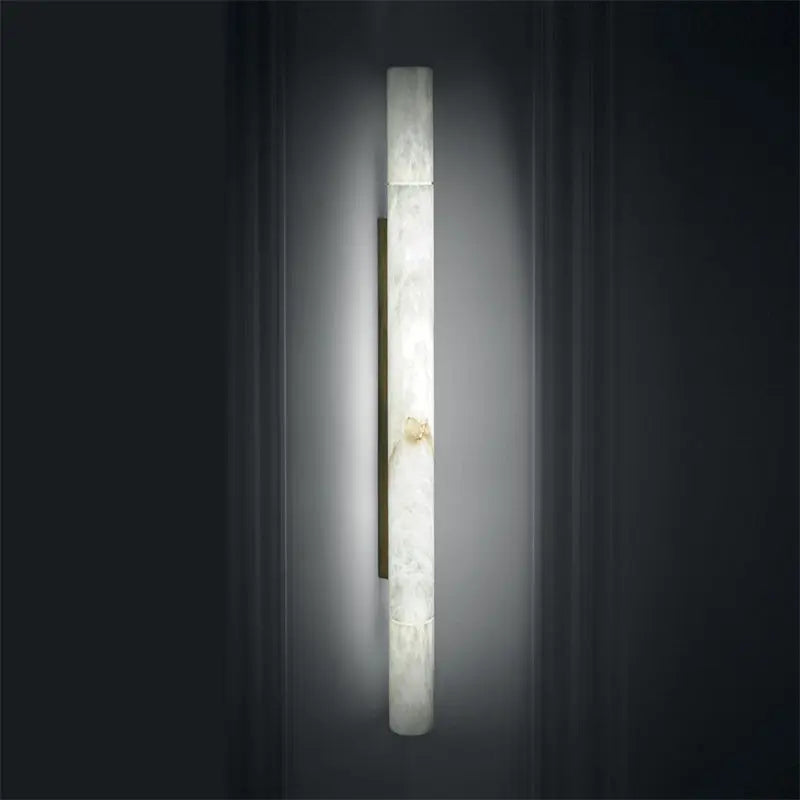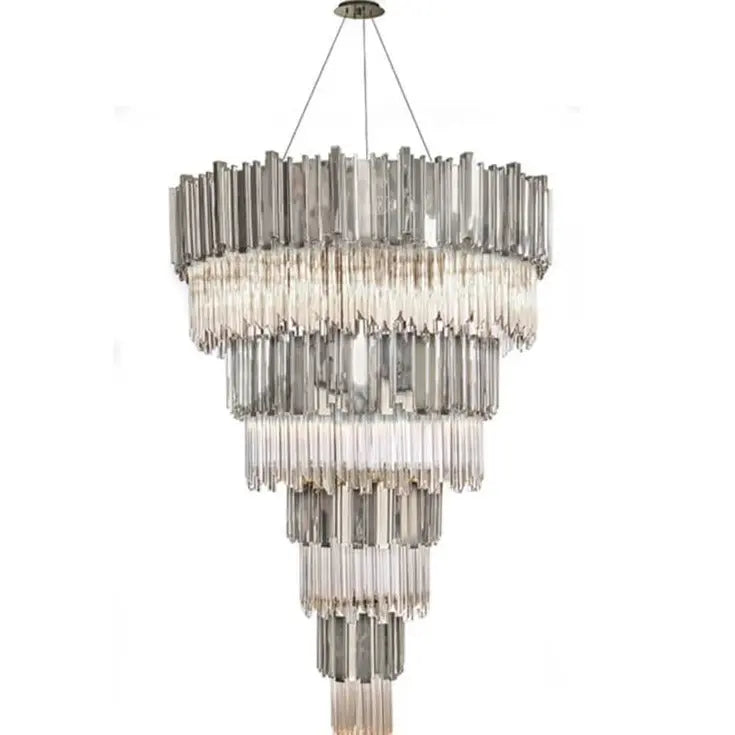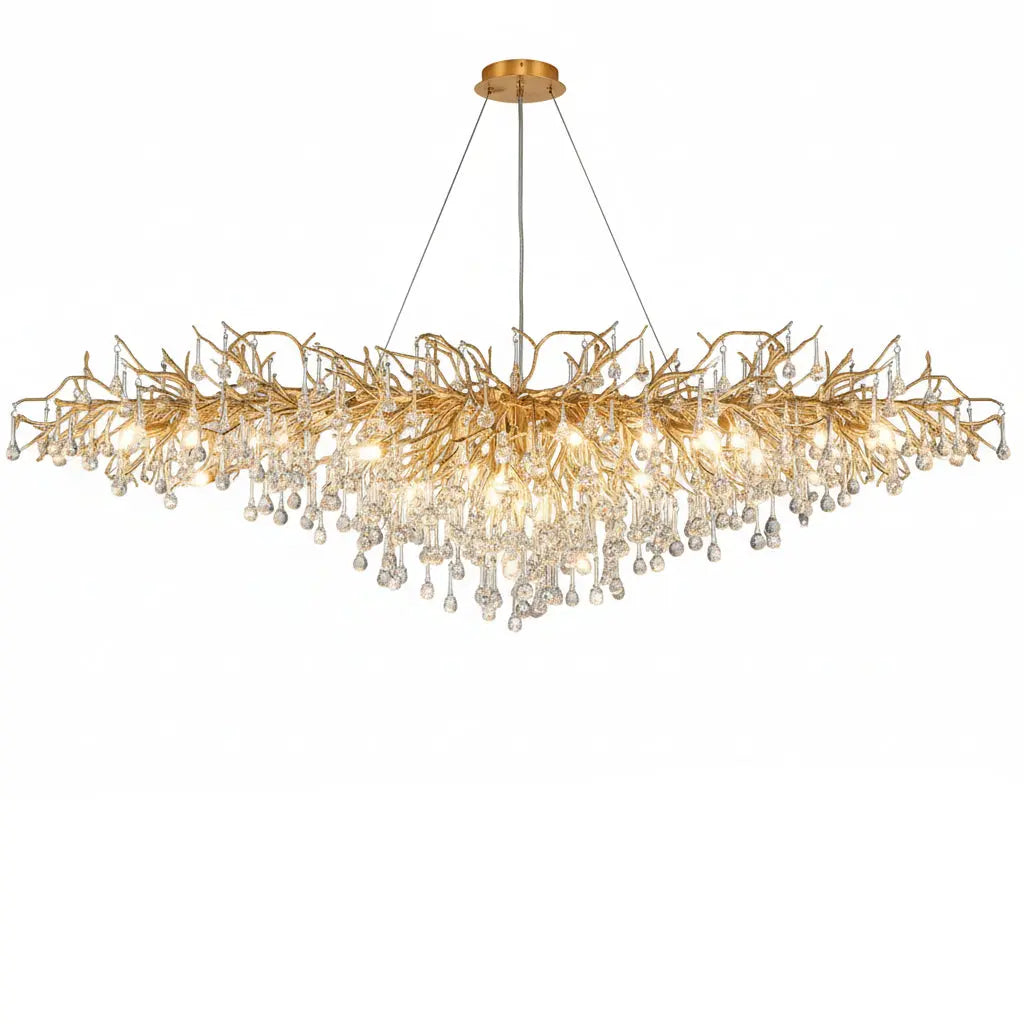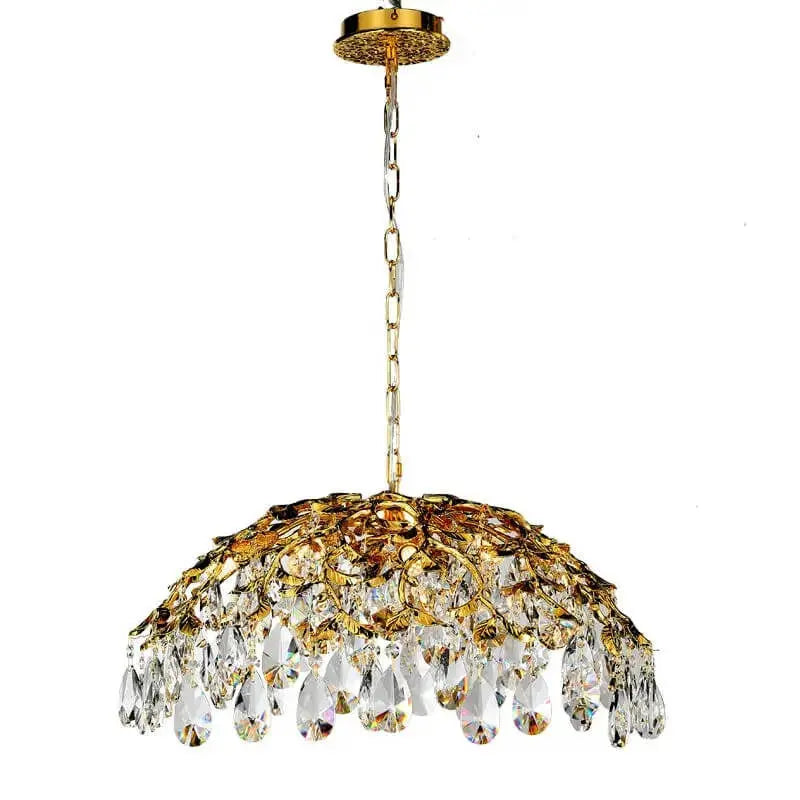When it comes to making your dining room cozy and inviting, the right lighting can make all the difference. This article explores the concept of visual comfort in dining room lighting and how to create a warm and welcoming atmosphere. From selecting the perfect chandelier to layering different types of light, we'll guide you through the essentials of lighting design that not only looks good but also feels good.
Key Takeaways
- Visual comfort is key for a pleasant dining experience.
- Choosing the right chandelier can enhance your home's style.
- Layering different light types creates a balanced atmosphere.
- Energy-efficient lighting helps save money and improve comfort.
- Natural light adds warmth and can be controlled with smart window treatments.
Understanding Visual Comfort in Dining Room Lighting
Defining Visual Comfort
Visual comfort is all about how lighting makes us feel in a space. It’s important to have the right balance of light so that the dining room feels inviting and cozy. Good lighting can change the whole mood of a room.
The Role of Lighting in Visual Comfort
Lighting plays a key role in creating a comfortable dining experience. Here are some important points to consider:
- Brightness: Too bright or too dim can be uncomfortable.
- Color Temperature: Warm lights create a cozy feel, while cool lights can feel harsh.
- Glare: Avoid lights that are too bright or direct, as they can cause discomfort.
Common Mistakes in Dining Room Lighting
Many people make mistakes when choosing lighting for their dining rooms. Here are some common ones:
- Ignoring Size: A small chandelier in a big room can look lost.
- Overlooking Layers: Relying on just one type of light, like a chandelier, can make the room feel flat.
- Neglecting Natural Light: Not considering how natural light affects the space can lead to poor lighting choices.
Remember, the right lighting can enhance your dining experience and make your meals more enjoyable.
For those looking to elevate their space, consider exploring alabaster chandeliers for a touch of elegance. They can add a unique style to your dining room while ensuring visual comfort.
Choosing the Right Chandelier for Your Dining Room
Matching Your Home's Aesthetic
When selecting a dining room chandelier, it’s essential to consider your home’s overall style. A chandelier should complement the existing decor rather than clash with it. Here are some styles to think about:
- Traditional: Ornate designs with crystals.
- Modern: Sleek lines and minimalistic features.
- Rustic: Wooden or wrought iron elements.
Chandelier Sizes and Placement
Choosing the right size for your chandelier is crucial. A chandelier that is too large can overwhelm the space, while one that is too small may not provide enough light. Here’s a simple formula to help you:
- Measure the width of your dining table.
- Add 12 inches to that measurement for the chandelier diameter.
| Table Width (inches) | Recommended Chandelier Diameter (inches) |
|---|---|
| 36 | 24 |
| 48 | 30 |
| 60 | 36 |
Incorporating Modern Chandeliers
Modern chandeliers can add a fresh touch to your dining area. Consider these options:
- Chandelier lights with LED bulbs for energy efficiency.
- Unique shapes that serve as a focal point.
- Chandelier lamp designs that blend functionality with style.
A well-chosen chandelier light fixture can transform your dining room into a welcoming space for family and friends.
In summary, when selecting a chandelier, think about your home’s style, the size of the fixture, and how modern designs can enhance your dining experience. Whether you opt for kitchen chandeliers or a stunning dining room chandelier, the right choice will create a beautiful ambiance.
Layering Light for Optimal Dining Room Ambiance
The Importance of Layered Lighting
Layering light is essential for creating a cozy and inviting dining room. By using different types of lighting, you can enhance the overall atmosphere. A well-lit dining room can make meals more enjoyable. Here are the three main types of lighting to consider:
- Ambient Lighting: This is the main source of light in the room, like ceiling lights or chandeliers.
- Task Lighting: This type helps with specific tasks, such as reading menus or setting the table. Examples include pendant lights or table lamps.
- Accent Lighting: This adds style and highlights certain features, like artwork or plants. Use spotlights or wall sconces for this purpose.
Combining Ambient, Task, and Accent Lighting
To achieve the best ambiance, combine all three types of lighting. For instance, a dining room chandelier can provide ambient light, while hanging lamps over the table serve as task lighting. Accent lights can be used to draw attention to decorative elements. Here’s a simple table to illustrate:
| Type of Lighting | Purpose | Examples |
|---|---|---|
| Ambient | General illumination | Ceiling lights, chandeliers |
| Task | Specific activities | Table lamps, pendant lights |
| Accent | Highlight features | Spotlights, wall sconces |
Using Dimmers for Flexibility
Dimmers are a great addition to your dining room lighting. They allow you to adjust the brightness based on the occasion. For example, you might want bright light for family dinners and softer light for romantic evenings. Using dimmers can greatly enhance your dining experience.
Layering light not only improves the look of your dining room but also makes it more functional. By carefully choosing your lights and their placement, you can create a space that feels just right for any occasion.
In summary, layering light is key to achieving the perfect dining room ambiance. By combining different types of lighting and using dimmers, you can create a space that is both beautiful and practical. Remember, the right chandelier light fixture can tie everything together, making your dining area a welcoming place for family and friends.
Energy Efficiency and Visual Comfort
Benefits of Energy-Efficient Lighting
- Lower energy bills: Using energy-efficient lights can save you money on your electricity costs.
- Longer lifespan: Energy-efficient bulbs last much longer than traditional ones, reducing the need for frequent replacements.
- Better for the environment: These lights use less energy, which helps reduce pollution and conserve resources.
LEDs and Their Impact on Visual Comfort
LED lights are a popular choice for dining rooms because they provide bright, clear light without using too much energy. They come in various styles, including chandelier lights and hanging lamps, making them versatile for any decor. LEDs can enhance visual comfort by offering a range of color temperatures, allowing you to choose warmer or cooler light based on your mood.
Balancing Efficiency with Aesthetic
When selecting lighting for your dining room, it’s essential to find a balance between energy efficiency and style. Here are some tips:
- Choose chandelier light fixtures that complement your dining room's design.
- Consider using dimmers to adjust the brightness and create the right atmosphere.
- Mix different types of lights, like ambient and task lighting, to enhance both comfort and style.
Energy-efficient lighting not only saves money but also creates a cozy and inviting atmosphere in your dining room.
By focusing on energy-efficient options, you can enjoy beautiful lighting while being kind to your wallet and the planet. Explore a wide range of ceiling light fixtures, including chandeliers, to find the perfect fit for your space.
Incorporating Natural Light in Dining Room Design
Maximizing Natural Light
To make the most of natural light in your dining room, consider these tips:
- Choose light-colored walls to reflect sunlight.
- Use large windows to let in more light.
- Position mirrors to bounce light around the room.
Window Treatments for Light Control
Selecting the right window treatments can help you control the amount of light entering your dining room. Here are some options:
- Sheer curtains allow light while providing privacy.
- Blinds can be adjusted to control brightness.
- Drapes can block out light when needed.
Blending Natural and Artificial Light
Combining natural light with artificial sources, like chandeliers or hanging lamps, creates a warm and inviting atmosphere. Here are some ideas:
- Use dimmer switches to adjust the brightness of your chandelier light fixture.
- Incorporate task lighting for activities like reading menus.
- Choose accent lights to highlight artwork or decor.
Natural light can transform your dining space, making it feel larger and more welcoming.
By thoughtfully incorporating natural light, you can enhance the overall comfort and style of your dining room, making it a perfect place for gatherings and meals. Remember, the right balance of light can significantly improve the ambiance, making your dining experience more enjoyable.
Highlights:
- illuminate your home: essential lighting ideas for every space
- kitchen chandeliers
- chandelier lamp
The Psychological Impact of Dining Room Lighting
Lighting and Mood Enhancement
The way we light our dining rooms can greatly affect our feelings and mood. Good lighting can create a warm and inviting atmosphere, making meals more enjoyable. Here are some key points to consider:
- Soft lighting can make the space feel cozy.
- Bright lights can energize the room, perfect for lively gatherings.
- Color temperature plays a role; warmer lights can be calming, while cooler lights can be refreshing.
Color Temperature and Its Effects
Different types of light bulbs give off different colors of light, which can change how we feel in a room. Here’s a simple breakdown:
| Color Temperature | Effect on Mood |
|---|---|
| 2700K - 3000K | Warm and cozy |
| 3500K - 4100K | Neutral and balanced |
| 5000K - 6500K | Bright and alert |
Creating a Welcoming Atmosphere
To make your dining room feel more inviting, consider these tips:
- Use hanging lights or a beautiful chandelier to draw attention.
- Layer your lighting with ambient, task, and accent lights.
- Add dimmers to control the brightness based on the occasion.
A well-chosen chandelier can transform a room, adding both light and style.
By understanding the psychological effects of lighting, you can create a dining room that not only looks great but also feels great for everyone who gathers there.
Trends in Dining Room Lighting Design
Current Trends in Lighting Fixtures
In today's homes, hanging lights are becoming very popular. Many people are choosing unique designs that stand out. Here are some trends:
- Industrial styles: These fixtures often use metal and glass, giving a modern look.
- Vintage designs: Retro lights and chandeliers are making a comeback, adding charm to dining rooms.
- Minimalist options: Simple and clean designs are favored for a sleek appearance.
Innovative Lighting Technologies
Technology is changing how we light our homes. Some exciting advancements include:
- Smart lighting: Control your lights with your phone or voice.
- LED options: These lights save energy and last longer than traditional bulbs.
- Color-changing bulbs: Adjust the color of your lights to match your mood or occasion.
Sustainable Lighting Solutions
More people are thinking about the environment when choosing lights. Here are some eco-friendly ideas:
- Use energy-efficient bulbs to save electricity.
- Choose fixtures made from recycled materials.
- Consider solar-powered lights for outdoor dining areas.
Lighting can transform a space. By choosing the right lights and chandeliers, you can create a warm and inviting atmosphere for your dining room.
In summary, the trends in dining room lighting design focus on creativity, technology, and sustainability. Whether you prefer hanging lamps or modern chandeliers, there are many options to enhance your dining experience.
Remember, the right lighting can make your dining room feel cozy and welcoming!
When it comes to dining room lighting, the latest trends are all about blending style with function. From sleek modern designs to classic elegance, there’s something for everyone. Don't miss out on the chance to transform your dining space! Visit our website to explore our stunning collection of chandeliers and lighting options that will brighten up your home beautifully!
Final Thoughts on Dining Room Lighting
In conclusion, good lighting in your dining room is really important for making the space feel cozy and inviting. Choosing the right chandelier can change the whole look of your room, whether you like a simple style, a boho feel, or a farmhouse touch. Remember, the right light not only brightens up your meals but also sets the mood for family gatherings and special occasions. So, take your time to find the perfect lighting that matches your home’s style and makes your dining area a warm and welcoming place.
Frequently Asked Questions
What is visual comfort in dining room lighting?
Visual comfort means having the right amount of light in your dining room so that it feels cozy and easy on the eyes. It helps you see well without straining.
How do I choose the right chandelier for my dining room?
When picking a chandelier, think about the style of your home. You can go for a simple look, a boho style, or something more rustic. Make sure it fits well with the room.
What are the best ways to layer lighting in my dining room?
Layering light means using different types of lights together. You can mix general lighting, task lighting, and accent lights to create a nice atmosphere.
Why should I consider energy-efficient lighting?
Energy-efficient lights, like LEDs, save money on your electricity bill and last longer. They also help make your dining room feel more comfortable.
How can I bring in more natural light?
To get more natural light, try using lighter window treatments or placing mirrors to reflect sunlight. This can make your dining room feel brighter.
What are some current trends in dining room lighting?
Right now, people love unique light fixtures and eco-friendly options. Modern designs and smart lighting that you can control with your phone are also popular.









































